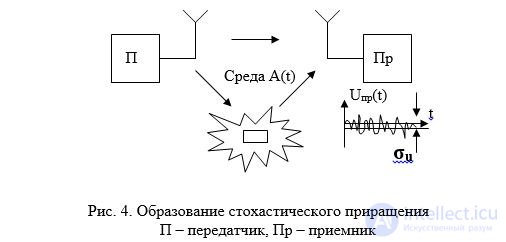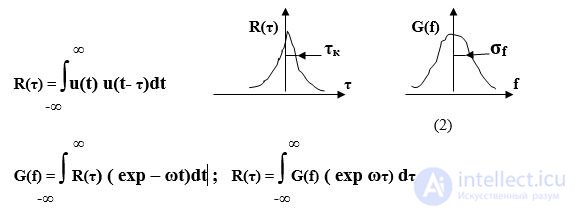Lecture
R ( τ ) Signal can be stochastic. Even if the RTS transmitter initially generates a deterministic signal u ( t ), but the radio wave passes through some kind of medium. Then the modulating function of the medium is imposed on the signal. A ( t ), as shown in fig. 4. And if the medium has a stochastic component, then the received signal will no longer be deterministic.

Fig. 4. The formation of stochastic increments
P - transmitter, Pr - receiver
The figure shows two variants of environmental exposure: during the operation of the radio communication system and the radar channel (a target appears in the medium with a randomly changing property of reflecting radio waves). Such phenomena are known in tropospheric radiocommunication (fading, blinking) and radiolocation ("irregularity" of the effective scattering surface diagram of the target). In this case, the feature of the waveform can be lost and the spectrum can be calculated by the direct Fourier transform. by type (1) will be impossible.
Here will help out the concept of the ACF - the autocorrelation function R (τ).

A pair of Fourier transforms link the spectrum of G ( f ) and the AQF R (τ ) on a power scale of W / Hz - for the spectrum and the mutual power of the signal in W while detuning τ. Of interest is the concept of a correlation interval τ k. It characterizes the speed of the process and to a certain extent replaces the concept of a signal duration. The width of the spectrum also has its own specifics. The shape of the envelope can be monotonous and asymtotic approaching zero. In this case, it is good to use the concept of the effective width of the spectrum σ f . It can be calculated and determine the base of the stochastic signal.
∞
σ f = [ ∫ G ( f ) df ] / G (0); B = σ f T c
-∞

RTS in the first stage of communication or radar should detect the signal. The detection efficiency can be estimated as the probability of detection. The amplitude is random. Therefore, a stochastic characteristic of the amplitude behavior is needed here. This is nothing more than the probability density of amplitude or the laws of distribution w ( u ).
RTS have basically two types of signal detectors: amplitude and phase (variety - frequency). Types of stochastic output signal differ. In fig. 5 shows the types of signals and amplitude distributions: Rayleigh and Gauss, respectively.

Fig.5. Detector output signals
w ( u ) = [ u / σ u 2 ] exp [- ( u - u ) 2/2 σ u 2 ] - Relay
w ( u ) = [1 / ( σ u √ 2π) ] exp [- ( u - u ) 2/2 σ u 2 ] - Gauss
Comments
To leave a comment
Radio Engineering Systems
Terms: Radio Engineering Systems